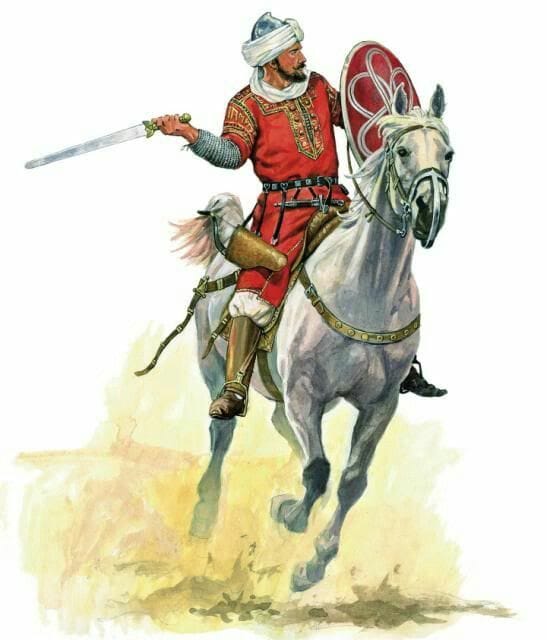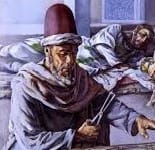The Involvement of the Saydjari Family


Courage & Readiness
Above is a rendering of the Saydjari family crest as described to us by our father. The lion represents courage and the horse the readiness of the Syrian warrior knights to protect their charges and defend their lands. The flower is the tuberose and was a favorite of the bin Munqidh clan
Saladin Coat of Arms
The Saydjari coat of arms on the left bears a remarkable resemblance to the official heraldic coat of arms of the Knights of the Order of Salahadin depicted above. The Knights of Salahadin (Saladin) are recognized by and work with the Knights Templar under the Treaty of Ramla.
Warrior Knights of Old – The Crusades and the Saydjari Clan
At the age of 90, a 12th-century noble from central Syria sat down at his desk, surrounded by books and memorabilia, to write his autobiography. This man, Usamah ibn Munqidh al Shayzari, was an Emir of Shayzar and had lived through almost the entire first century of the Crusades. He had seen both fierce conflict and extended truces. Usamah recorded his exciting and epic journey from the point of view very unfamiliar to most Western readers – that of a Muslin Knight
The Early Years
Usamah fought in many battles against the attacking Christians during the Second Crusade. He wrote extensively about the conflict in his book, Memoirs of an Arab-Syrian Gentleman, which was filled with vivid descriptions of having been cut and stabbed with swords during battle.
He described his first battle against the Crusaders and commented: “O my lord, that was the first fight in which I took part [August 4, 1119]…. But the moment I saw that the Franks [crusaders] were in contact with our men, then I felt that death would be an easy matter for me. So I turned back to the [crusaders], either to be killed or to protect that crowd.” Following his code of honor, Usamah fought in battle after battle, defending his homeland and its people, neither fearing death nor injury. This book is considered one of the most valuable descriptions of the Crusades from a non-Western perspective.
Usamah’s Link to Shayzar
Usamah was born July 4, 1095 CE, in the castle of Shayzar, the Saydjari family’s ancestral home. He was the nephew and potential successor of the emir of Shaizar. However, he was exiled in 1131 to make way for the succession of the Emirs newly born son. Usamah spent the rest of his life serving other leaders.
A Servant of Many Masters
He served Zengi, Nur ad-Din, and Saladin over a period of almost fifty years. Usamah also became an advisor to the Fatimid court in Cairo, as well as the Artuqids in Hisn Kayfa. He traveled extensively in Arab lands, visiting Egypt, Syria, Palestine, and the Tigris River. Although much of his clan was destroyed in the earthquake of 1157 CE, Usamah and a few others survived.
It is to him and these survivors and even further back in time that the Saydjari family traces its origins. He had three brothers, Muhammad, ‘Ali, and Munqidh. His son Murhaf was born in 1126. He had another son, Abu Bakr, who died as a child. A daughter, Umm Farwa, was born in Hisn Kayfa in 1166. Usamah mentioned some additional children, but their names, and the names of his wife or wives, are unknown.
Later Life
Usamah was a famous and well-regarded military advisor and diplomat but was most well-known as a poet and adib (a “man of letters”). He compiled many books of contemporary poetry, including the Kitab al-‘Asa (“Book of the Staff”), Lubab al-Adab (“Kernels of Refinement”), and al-Manazil wa’l-Diyar (“Dwellings and Abodes”) as well as original works. In modern times, he is remembered more for his Kitab al-I’tibar (“Book of Learning by Example” or “Book of Contemplation”), which contains lengthy descriptions of the Crusades.
Although he opposed the Crusades as an unbearable invasion of his homeland, he made friends and allies among some of the Crusader armies. Saladin carried an anthology of poetry created by Usamah, who was his trusted advisor. An old Bedouin poem favored by Saladin contains the line “The sword is truer than what is told in books: In its edge is the separation between truth and falsehood.”
The Knights Templar
Not all crusaders saw Muslims as enemies. The original Knights Templar rejected the idea of the Crusades as a call to eliminate Muslims or eradicate Islam. The Templars felt that the Crusades did not defend Christianity but instead strove to plunder, despoil, and kill. Contrary to popularized Western misconceptions, the Templars did not see Muslims as the enemy. They saw the real “enemies of Christ” could be and often were evil-doers pretending to be Christians. Such men were seen as the enemies of all faiths.
Usamah & Saladin
The Templars were not anti-Muslim but were warrior monks fighting for good against evil, regardless of which religions were involved. Usamah and Salahadin (Saladin) found mutual respect and admiration in the ranks of the Templar Knights. Both sides shared a code of honor and chivalry that each found familiar. For example, in the Oxford History of the Crusades edited by Jonathan Riley-Smith, Usamah was noted to be friendly with a group of Templars who protected him from harassment by over-zealous crusaders from another order.
Saladin became General and then the first Sultan of Egypt and Syria in 1169 CE after a meteoric rise to power. He founded the Ayyubid dynasty (Al-Ayyūbīyūn) (الايوبيون) in 1174 CE. His empire eventually expanded to include Mesopotamia, Yemen, and parts of North Africa.
The Modern Knights Templar
The modern Order of the Temple of Solomon honors the Treaty of Ramla of 1192 CE, reconfirmed by the Treaty of Acre of 1229 CE, establishing cooperation and peace between the Knights Templar and the Muslim Saracen Knights of Arabian Chivalry, to defend all Faith (of all religions), to uphold good over evil. The historical record demonstrates Muslims were admitted to membership in the Templar Order, and the Sultan Saladin himself was given the Templar Knighting Ceremony near Alexandria.
Chivalry
The unique tradition of Templar Chivalry of the 11th-12th centuries was greatly influenced by ancient Arabian Chivalry (Al-Furúsiyyah Al-Arabiya) (الفروسا العربيه), although European Chivalry had its own ancient roots. This Chivalry of Honor, markedly different from the brutality of the early Crusades, was transplanted to Western Europe due to contact with Arab knights during the Crusades.
This brand of Chivalry (Furúsiyyah) (فروسه) spread from the Arabian Peninsula through the 8th century Muslim “Moors” of the Iberian Peninsula (covering Spain, Portugal, Andorra, and part of Southern France). Troubadours from the Arab courts in Andalusia (Spain) adopted the code and helped spread the medieval culture of Chivalry across Europe. Arabian Chivalry was focused on a code of “Virtue” and “Honour,” which was considered more important than religious doctrines. An old Bedouin aphorism roughly translates, “There can be no religion without virtue.”
Usamah’s Death
Usamah died November 17, 1188 CE at the age of 93, and is buried in a lost tomb somewhere on Mount Qasioun overlooking Damascus.


